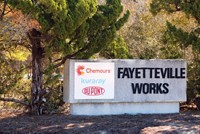Advertisement
Grab your lab coat. Let's get started
Welcome!
Welcome!
Create an account below to get 6 C&EN articles per month, receive newsletters and more - all free.
It seems this is your first time logging in online. Please enter the following information to continue.
As an ACS member you automatically get access to this site. All we need is few more details to create your reading experience.
Not you? Sign in with a different account.
Not you? Sign in with a different account.
ERROR 1
ERROR 1
ERROR 2
ERROR 2
ERROR 2
ERROR 2
ERROR 2
Password and Confirm password must match.
If you have an ACS member number, please enter it here so we can link this account to your membership. (optional)
ERROR 2
ACS values your privacy. By submitting your information, you are gaining access to C&EN and subscribing to our weekly newsletter. We use the information you provide to make your reading experience better, and we will never sell your data to third party members.
Litigation
Companies agree to PFAS settlement with US public water systems
Agreement by Chemours, DuPont, and Corteva would provide more than $1 billion to municipalities to clean up contamination
by Britt E. Erickson
June 5, 2023

Chemours, DuPont, and Corteva Agriscience have agreed to settle claims over contamination of public water supplies with per- and polyfluoroalkyl substances (PFAS). The tentative settlement, which has yet to be court approved, aims to resolve multidistrict litigation involving more than 3,000 cases pending before the US District Court for the District of South Carolina.
The plaintiffs generally allege that the use of firefighting foam containing perfluorooctanoic acid (PFOA) or perfluorooctanesulfonic acid (PFOS)—two of the most harmful PFAS—contaminated public water supplies near military bases, airports, and industrial sites. The cases, filed by municipalities across the US, were centralized in 2019 under the South Carolina court. The agreement does not pertain to personal injury suits, in which individuals allege their health was harmed by PFAS in drinking water.
The three chemical makers have agreed to contribute a total of $1.185 billion to a settlement fund. Chemours will provide half of the money, and DuPont and Corteva will contribute the rest, in line with an agreement the three hashed out in 2021. DuPont spun off its PFAS business to Chemours in 2015. Corteva, which includes agricultural assets from DuPont and Dow, took on some of DuPont’s liabilities.
The money would be split between thousands of municipalities across the US that are suing the chemical manufacturers to pay for remediation of polluted water supplies. It is unclear how much of the money would go to pay lawyer fees, and plaintiffs have the option to opt out of the settlement and continue litigation. If opt-outs exceed a certain level, the companies can terminate the agreement.
Environmental advocates say $1.185 billion is not nearly enough money. “It will take tens of billions, if not more, to clean up all of the PFAS-contaminated water,” says Kyla Bennett, director of science policy at Public Employees for Environmental Responsibility. “My town of roughly 25,000 people had to install a filtration system that cost over $9 million” to remove PFAS, she says.
Individual municipalities are likely to get a few hundred thousand dollars, not millions, out of the settlement, depending on the number of plaintiffs. And if enough plaintiffs opt out, the whole deal could fall apart, Bennett notes.
3M, which is also being sued by public water utilities for PFAS contamination, has yet to say how much it is willing to pay to resolve the cases.
The first trial in the multidistrict litigation was scheduled to begin June 5. The case, City of Stuart, Florida v. 3M, is considered a bellwether trial for the thousands of other cases involving PFAS-contaminated water supplies from firefighting foam. US District Judge Richard Gergel postponed the trial the morning it was to start at the request of both parties, who told the court an agreement is achievable in the near future. If an agreement is not reached in 21 days, the trial will be rescheduled.




Join the conversation
Contact the reporter
Submit a Letter to the Editor for publication
Engage with us on Twitter